Snakes are among the most widespread animals on Earth, with over 3000 distinct species, except for Antarctica. Although 3000 species may seem like a lot, each species is distinct. Snakes can be venomous or non-venomous, entirely aquatic or fully terrestrial, or occasionally a combination.
Banded snakes are among the most distinctive species of snakes that have ever existed. They are snakes with skin-encircling bands, as their name would imply. Banded snakes come in a variety of species, each of which is unique in its way. Want to know more about banded snakes and find out what the largest banded snake is? Stick around.
Types of Banded Snakes; How To Identify Each One
As previously mentioned, banded snakes have extremely distinctive skin surrounded by colorful bands. This indicates a snake is banded if its skin is laced with colored lines that resemble rings. There are numerous types of banded snakes, just as there are numerous different species of snakes. Here are a few of them:
1. Mud Adders
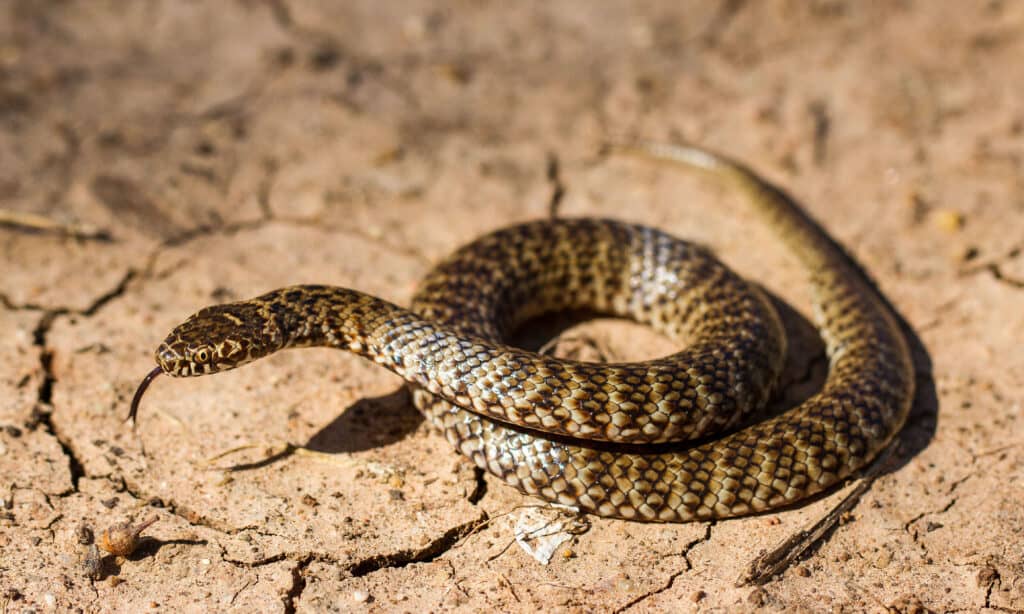
Mud adders have short, somewhat flattened bodies and some degree of body thickness.
©Ken Griffiths/Shutterstock.com
The Elapidae family of snakes includes mud adders, also known as De Vis banded snakes or Denisonia devisi. The species is only found in a few isolated areas of eastern Australia. Charles Walter Devis, the first director of the Queensland Museum and a writer on herpetology, was the inspiration for the species’ scientific name.
Mud adders are not the largest banded snakes; they are not even close to the title. Despite the lack of precise measurements for the species, it is worth noting that mud adders have short, somewhat flattened bodies and some degree of body thickness. The dorsal surface of most mud adders is olive green or yellowish brown. To qualify as banded snakes, they also have irregular, narrow, dark bands running across their bodies.
Low-lying locations, particularly those that experience frequent floods, are popular habitats for mud adders. Despite being venomous, mud adders are very docile snakes, sometimes even sluggish. They generally remain in soil cracks during the day. However, they are more active at night when looking for food. Their primary food sources are frogs, toads, and sometimes other reptiles.
2. Banded Water Snakes
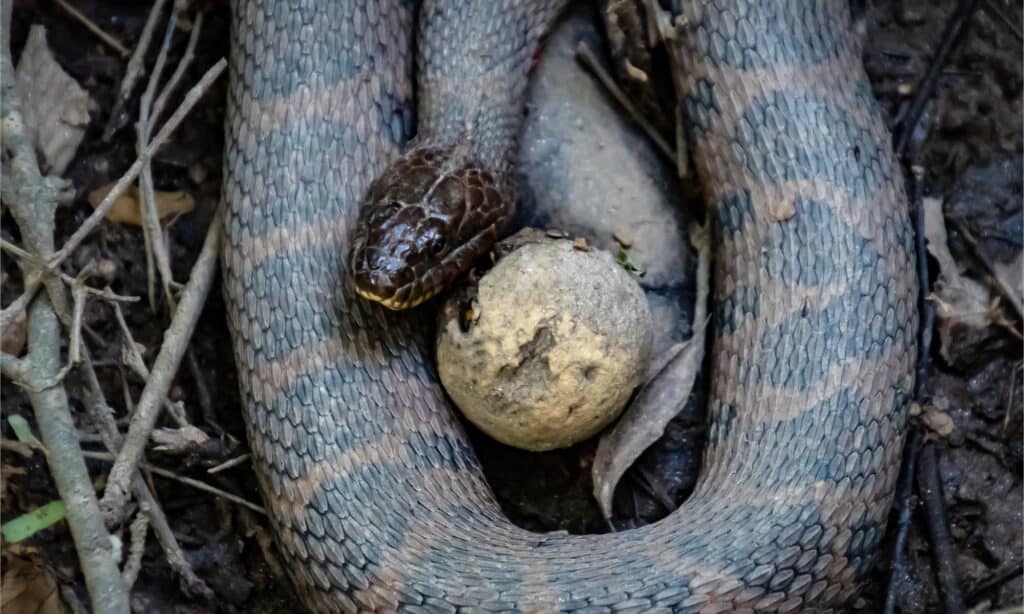
Banded water snakes are active day and night and are frequently spotted close to several aquatic habitats.
©Deborah Ferrin/Shutterstock.com
Banded water snakes are primarily aquatic, non-venomous snakes native to the midwest and southeastern regions of the United States, including Indiana, Louisiana, Florida, etc. They are also known by the names Nerodia fasciata or southern water snakes. The coloration of banded water snakes varies; they can be anything from light brown or reddish to gray or black with darker crossbands. The bands on this species’ skin may vanish as it ages.
Banded water snakes are active day and night and are frequently spotted close to several aquatic habitats. These species prefer freshwater environments like lakes, ponds, streams, etc. They can also often be spotted lounging on logs or branches that dangle over the water or hunting in shallow water for their main diet, fish, and other smaller amphibians. Flat-headed and reasonably heavy-bodied, banded snake adults can reach lengths of up to 42.1 inches (61 to 107cm). Florida produced the longest banded water snake, which measured 62.5 inches (158.8cm) long.
3. White Banded Wolf Snakes
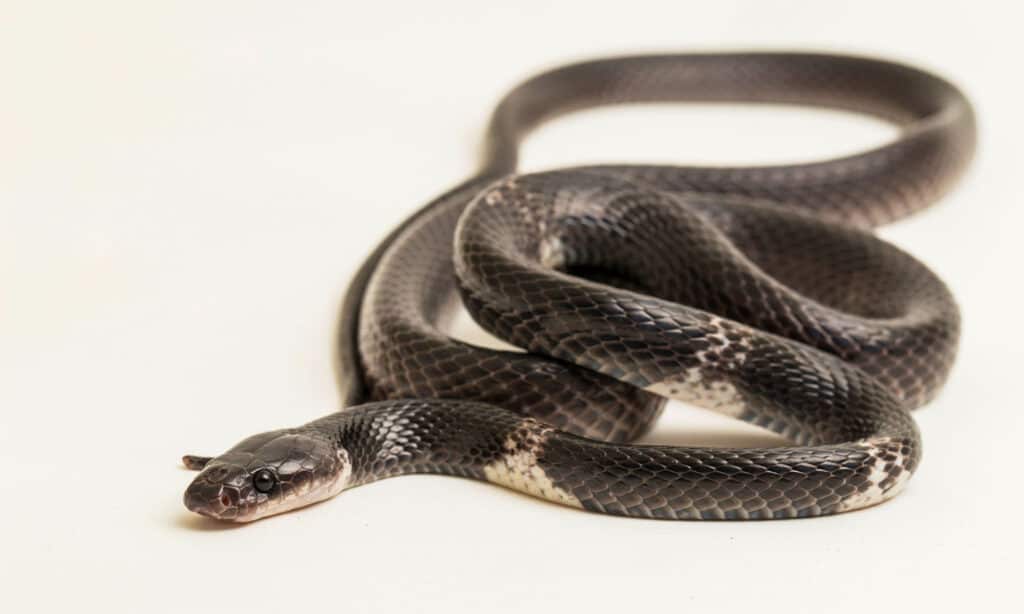
White-banded wolf snakes have dark brown tails and black skin.
©dwi putra stock/Shutterstock.com
White-banded wolf snakes, also known as Lycodon septentrionalis or the northern large-toothed snake, are a Colubrid snake found in Asia. These species are frequently confused for the many-banded krait. However, they differ because they have wide rostral scales, a flatter snout, and relatively small eyes. Asia is home to white-banded snakes, common in the northeastern regions of India, Vietnam, Thailand, and the Yunnan province of China.
Like many-banded kraits, white-banded wolf snakes have dark brown tails and black skin with narrow whitish transverse bands forming entire rings around their tails. The belly of white-banded wolf snakes is pale and covered in brown dots. Also, adults may reach three feet (91.4 cm) with their tails at least eight inches. Most of the time, white-banded wolf snakes are nocturnal and spend the night looking for prey, mainly small lizards. They prefer to forage near water and forest floors despite being terrestrial creatures. Despite being generally fairly docile, this species will attack without hesitation if they feel threatened.
4. Many-Banded Krait
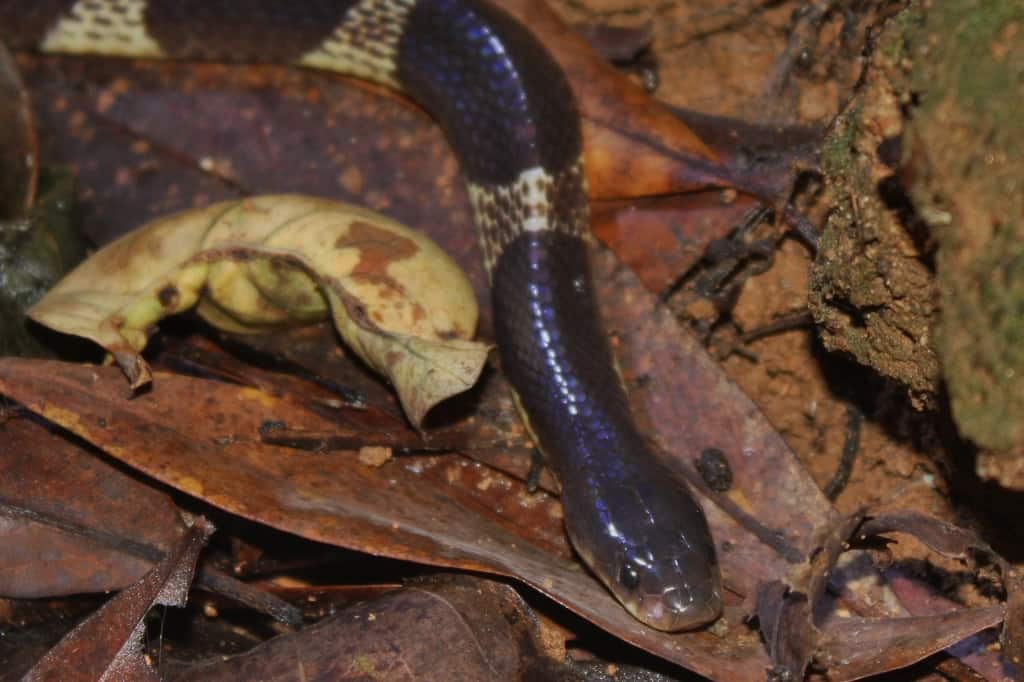
Many-banded kraits can reach 3.5 to 5 feet (1 to 1.5 meters).
©Thomas Brown / CC BY 2.0 – License
The venomous many-banded krait is one of the elapid snake species found throughout most of Southeast Asia, particularly in central and southern China. The many-banded krait, Bungarus multicinctus, is also referred to as the Taiwanese krait or the Chinese krait. These species have black or dark blue skin with numerous white streaks. Their heads are black, flat, wide, and elliptical, and their bodies are likewise more slender. In addition to having short, pointed tails, many-banded kraits can reach lengths of 3.5 to 5 feet (1 to 1.5 meters), with the biggest one ever seen is 6.1 feet (1.85 meters).
5. Banded Kraits
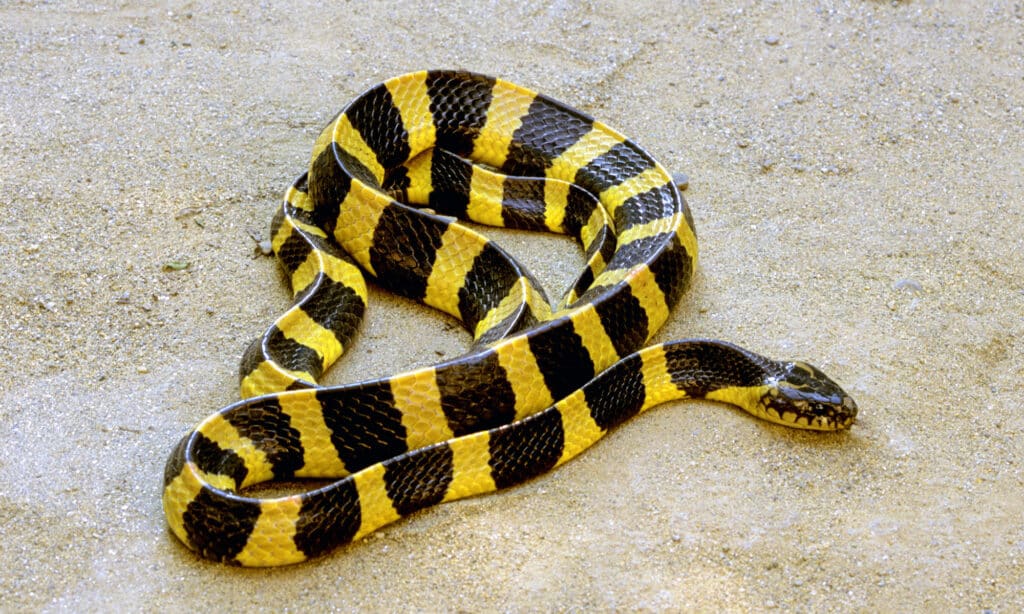
The dorsal scales of banded kraits contain 15 rows, and their small tails resemble fingers.
©RealityImages/Shutterstock.com
The banded krait (Bungarus fasciatus), mostly found in Southeast Asia, southern China, and the Indian subcontinent, is easily recognized by the alternately black and yellow cross bands that wrap its body. Flat heads with arrowhead-like patterns, yellow lips, and throats are other features of banded kraits. This species’ maximum length, typically growing very long, is 5 feet, 11 inches (1.8 meters). The longest banded krait recorded was 7 feet 5 inches (2.25 meters) long.
The dorsal scales of banded kraits contain 15 rows, and their small tails resemble fingers. Additionally, they like living in various habitats such as woodlands, agricultural regions, and termite and rodent burrow near water. Despite their shyness and dislike of being observed, banded kraits are more active and aggressive at night. Their diet consists of smaller snakes, fish, frogs, and skunks.
What is The Largest Banded Snake Ever Recorded?
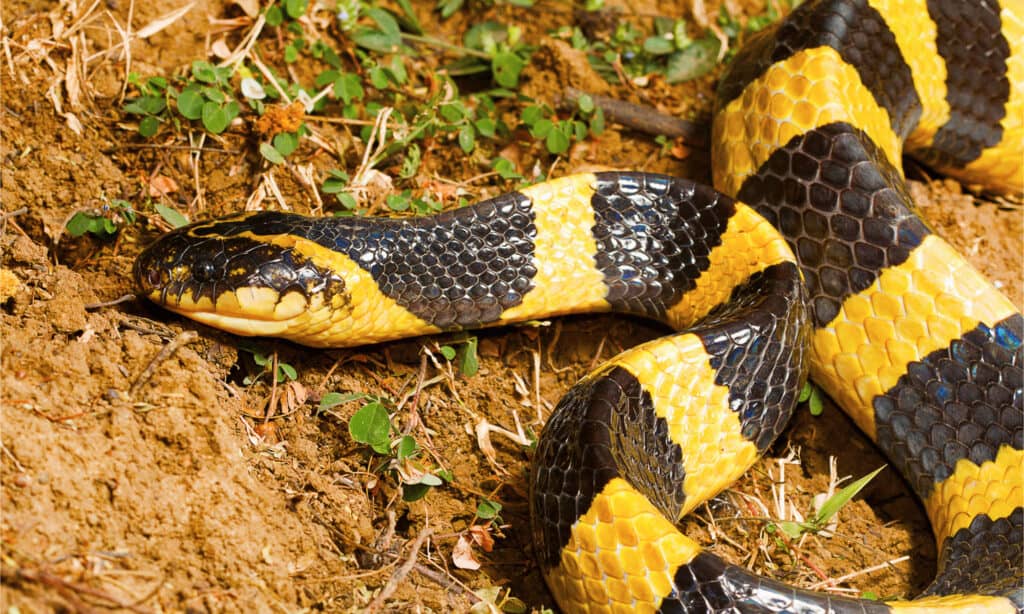
The longest banded krait ever was measured at 6.1 feet (1.85 meters) long.
©RealityImages/Shutterstock.com
As indicated, there are numerous varieties of banded snakes, even more than those covered in this article. While some do not, others tend to get quite long. The banded krait, which typically reaches lengths of up to 5 feet, 11 inches (1.8 meters), is the largest of all banded snakes. The longest banded krait measured was 6.1 feet (1.85 meters) long, making it the longest-banded snake ever recorded.
How Long Do Banded Snakes Live?
Snakes and other reptiles seem to have cells that don’t show signs of aging as fast as mammals of the same size. Thus, their lifespan may be longer than you might imagine.
The length of their life depends on being in the wild or in captivity, like many animals. Banded water snakes live up to eight years in the wild. Banded Kraits and many-branded kraits live up to 13 years. The White Banded Wolf Snakes live up to around 10 years. Mud adders can live even longer than the rest.
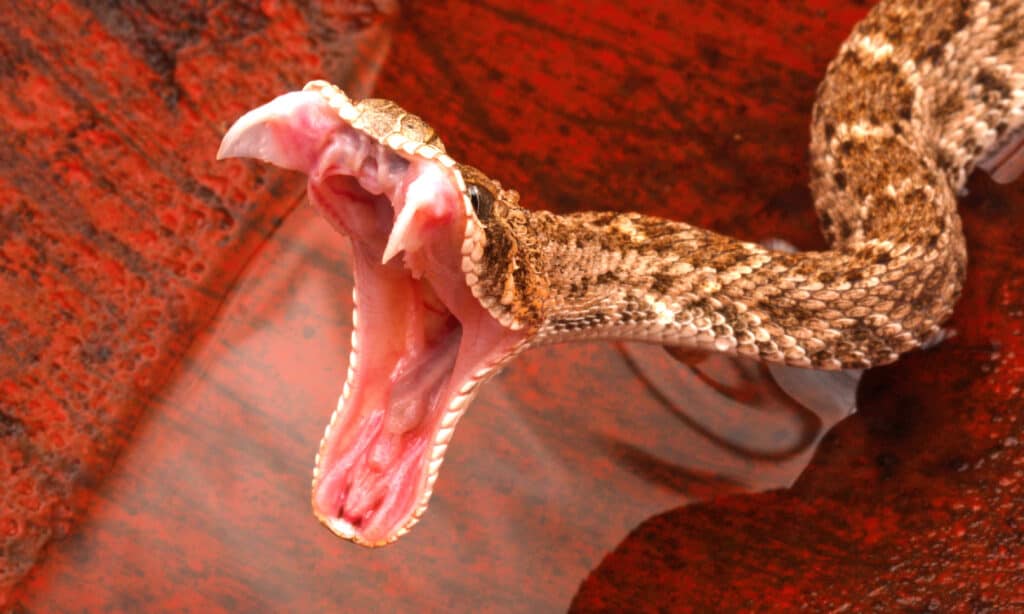
Not all banded snakes are venomous.
©iStock.com/johnaudrey
Are Banded Snakes Venomous?
Contrary to what many people believe, not all banded snakes are venomous. Numerous species of banded snakes are relatively calm and rarely bite unless provoked. Even when disturbed, many either hide or flee, but if cornered, they will defend themselves. Many dislike being picked up or handled in any way, which may lead to an attack. Even though not all banded snakes are venomous, they all have sharp teeth that cause painful bites. Banded kraits, many-banded kraits, mud adders, and other banded snakes are examples of venomous banded snakes.
Other Record-Breaking Snakes
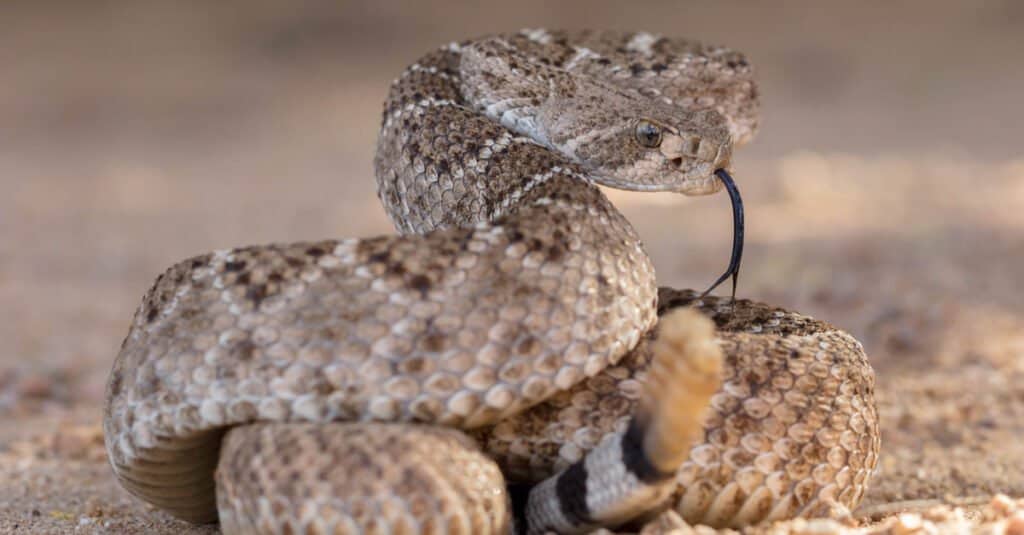
Most western diamondback
rattlesnakes
are around four feet long – but they are known to grow up to six feet or more.
©Alexander Wong/Shutterstock.com
Not all banded kraits are venomous – but all rattlesnakes are venomous and potentially deadly – and the Western diamondback is no exception. Native to the southwestern United States and northern Mexico, western diamondback rattlesnakes can be found in desert or semi-desert regions. Rattlesnake venom is hemotoxic, meaning that it can affect blood cells, and blood vessels, and induce hemorrhaging. Western diamondbacks average 4 feet in length, but they have been known to be larger. Just how long is the largest western diamondback rattlesnake? Hint: it’s over six feet long. Find out just how long the largest western diamondback is – and discover the largest rattlesnake of all time in this next post!
The photo featured at the top of this post is © iStock.com/ePhotocorp
Discover the "Monster" Snake 5X Bigger than an Anaconda
Every day A-Z Animals sends out some of the most incredible facts in the world from our free newsletter. Want to discover the 10 most beautiful snakes in the world, a "snake island" where you're never more than 3 feet from danger, or a "monster" snake 5X larger than an anaconda? Then sign up right now and you'll start receiving our daily newsletter absolutely free.
Thank you for reading! Have some feedback for us? Contact the AZ Animals editorial team.






